Uganda Health Workforce Study: - IntraHealth International
Uganda Health Workforce Study: - IntraHealth International
Uganda Health Workforce Study: - IntraHealth International
You also want an ePaper? Increase the reach of your titles
YUMPU automatically turns print PDFs into web optimized ePapers that Google loves.
AbstractThis report summarises the results of a study of health worker satisfaction, workingconditions and intent to continue working in the health sector in <strong>Uganda</strong>. The findings pointto the importance of a number of factors that contribute to satisfaction and intent to stay,including differences by cadre, gender, age, sector (public or non-profit) and location. Theresults suggest several policy strategies to strengthen human resources for health in <strong>Uganda</strong>.More than 700 health professionals were surveyed in nine districts and 18 health facilities.Three focus groups were conducted in each facility, with health workers separated by cadre(physicians, nurses and allied health). The study was conducted in July 2006 using a team of20 <strong>Uganda</strong>n health professionals, most of them recent graduates of or current students atthe universities in Kampala. The study was conducted by the USAID-funded Capacity Projectwith the <strong>Uganda</strong> Ministry of <strong>Health</strong>, with support from the US <strong>Health</strong> Resources andServices Administration and three universities (Makerere, Aga Khan and University ofWashington). It was conducted under the oversight of the <strong>Uganda</strong> <strong>Health</strong> <strong>Workforce</strong>Advisory Board, a group of <strong>Uganda</strong> health system stakeholders.<strong>Uganda</strong> <strong>Health</strong> <strong>Workforce</strong> <strong>Study</strong>:Satisfaction and Intent to Stay Among Current <strong>Health</strong> Workersiii
AcknowledgementsThe <strong>Uganda</strong> <strong>Health</strong> <strong>Workforce</strong> <strong>Study</strong> was conducted and the data thereof provided by theMinistry of <strong>Health</strong> of the Republic of <strong>Uganda</strong>, with funding from the United States Agencyfor <strong>International</strong> Development (USAID)-supported Capacity Project/<strong>Uganda</strong> and the US<strong>Health</strong> Resources and Services Administration (HRSA). Recognition is also made of thecontributions to data collection by Aga Khan University-Kampala Nursing School, MakerereUniversity Medical School and the University of Washington School of Public <strong>Health</strong>.We appreciate the participation of each health worker who took time to fill out aquestionnaire or attend a focus group discussion. Hospital administrators, nursing directorsand medical superintendents were most gracious. We also appreciate the time of each ofthe district directors of health services in our nine regions. Kibuli Muslim Hospital inKampala offered valuable assistance by volunteering to host our teams during training as atest site.Unfortunately, our computers for data entry became infected with a virus and some fileswere corrupted. We were ably assisted in sorting out this difficulty by Nathan Natseri of the World <strong>Health</strong> Organization in Kampala, and we aregrateful to him.Kibuli Muslim Hospital served as our field worker training and testing site at the outset ofthe project, and we are grateful for that cooperation.The official list of <strong>Uganda</strong> health professional training schools (not including universities) wasreceived from the European Union’s Developing Human Resources for <strong>Health</strong> program,coordinated through the African Medical and Research Foundation (AMREF). Our thanks toEdward Walugembe, Carol Idusso and Deana Leadbeter for this list. Thanks also to theEuropean Union for the list of National Classification of <strong>Health</strong> Occupations (based on the<strong>International</strong> Standard Classification of Occupations, or ISCO) codes adapted for use inhealth professions in <strong>Uganda</strong>.AuthorshipThis draft of the executive summary has been authored by Amy Hagopian, PhD, withsupport from the USAID-funded Capacity Project and the US <strong>Health</strong> Resources and ServicesAdministration. Dr. Hagopian analyzed the quantitative data with statistical assistance fromBert Stover, PhD and Emily Bancroft, MPH. Editing assistance was provided by JimMcCaffery, Ph.D. , Pamela McQuide, Ph.D., Anneke Zuyderduin, Ph.D. Fatu Yumkella, Msc,MPhil., Paul Kiwanuka-Mukiibi, M.D., and others at the Capacity Project.Analysis of the qualitative data in this study was conducted by Dr. Stella Neema of theMakerere University Social Institute for Social Research.<strong>Uganda</strong> <strong>Health</strong> <strong>Workforce</strong> <strong>Study</strong>:Satisfaction and Intent to Stay Among Current <strong>Health</strong> Workersiv
4.2 Demographics and LocationThe average health worker in the study was female and married with seven dependents.Most respondents (64%) worked in the public sector. The average respondent was 39 yearsold, and this average age held across three of five cadres, although medical officers wereslightly younger (age 36) and pharmacy staff slightly older (age 43). Nurses comprised 55% ofthe sample, were mostly female (89%) and were the cadre least likely to be married (57%),perhaps because a portion of this group includes Catholic Sisters. Allied health workerswere mostly male (83%), and 83% were married. Physicians were almost all (90%) men, and62% were married.Public-sector workers were older (average age 42 compared to 35), had been at their jobslonger (11 years compared to 7 years) and with their organisations longer (15 yearscompared to eight years). They are also more likely to be male (43% compared to 29%),married (70% compared to 51%) and have more dependents (7.7 compared to 5.6).<strong>Health</strong> workers were likely to be working in the regions where they were born, except inKampala. Hospitals that organise their own training schools usually employ large numbers oftheir own graduates. There were no significant differences among health care workerprofiles in hard-to-reach areas compared to those working in “easier” areas.Managers tended to be male (64%), older (67% were over 40) and stable (48% had been intheir positions for at least 10 years).4.3 Job Stability and Longevity Are HighWe found remarkable stability in the health workforce. Our sample, by design, was drawnfrom the people we found on the job in hospitals (not people who have already left), givingus what is called in statistics a “survivor’s bias,” and we have no comparison numbers onlongevity or turnover to help us evaluate the significance of our findings. It is remarkable,nonetheless, that 81% of our respondents were still in their first jobs. The average length ofstay was 10 years, with 13 years working for the same employer and 13.5 years in theirprofessions overall.Slightly more than half (54%) of health workers planned to stay in their jobs indefinitely, andanother 20% would stay at least three years. The rest reported that they were eager toleave their jobs soon, with 9% saying “as soon as possible.” Of those ready to leave soon,11% would leave <strong>Uganda</strong> and 4% would leave the health sector. Older respondents (age 41and up) were far less likely to indicate an intent to leave their jobs within two years, leave<strong>Uganda</strong> or leave the health profession. Private-sector workers were more likely to be intheir first jobs (86%) compared to workers in the public sector (79%).Doctors, compared to the other cadres in our study, were the group most likely to say theyare eager to leave their jobs within two years (57%), and they are most at risk for leaving<strong>Uganda</strong> or the health sector (46% said they would leave if they could). Regression analysishelped us determine that even after gender was accounted for, the status of being a doctorwas highly predictive of a desire to leave their positions.Nurses were the cadre least likely to report an interest in leaving <strong>Uganda</strong> or the healthprofession (80% intended to stay in their jobs at least three years), and with 85% still in theirfirst jobs. For one point of reference, there is about a 20% turnover among nurses in the US<strong>Uganda</strong> <strong>Health</strong> <strong>Workforce</strong> <strong>Study</strong>:Satisfaction and Intent to Stay Among Current <strong>Health</strong> Workers3
and UK annually 3 . Clinical officers also showed low turnover numbers, with a large majoritystill in their first jobs (87%) and most (77%) reporting an intent to stay in their jobs.Region was a significant predictor of intent to stay overall. Living in the central region,compared to other regions, increases the odds of leaving when other factors remainedequal. The region where health workers expressed the least likelihood of leaving was thenorth.In regression analysis, when considering age, gender, cadre, sector and regionsimultaneously, odds were more than two times higher intent to leave <strong>Uganda</strong> or the healthsector when respondents rated more highly the importance of salary, other factors beingequal.Besides the importance of salary, factors that reduced the odds of leaving included thefollowing, with all other factors in the equation held equal, in order of importance:• Active involvement in the facility• Manageable workload• Flexibility to balance the demands of work and personal life• Better opportunities for promotion.Comment: <strong>Health</strong> sector jobs are relatively high status, stable and reasonably compensatedcompared to many alternatives for educated people in most countries, which may explainsome of the job longevity we view in this sample. The international literature on healthworker turnover, however, cautions us that there is a strong relationship between intent toleave and turnover, and that job satisfaction is predictive of turnover 4 . There areconsiderable regional differences in our findings (health workers in Kampala are much morelikely to leave their positions than workers in the north), as well as differences among cadres(physicians are much more eager to leave their positions than nurses). The importantconclusion from our study, however, is that if the stability within the workforce continues asin the past, there is no imminent danger of a broad-scale exodus of health workers fromtheir jobs in <strong>Uganda</strong>.4.4 Workers Are Divided as to Satisfaction and Morale<strong>Health</strong> worker job satisfaction and motivation is related to the worker’s ability, willingnessand means to achieve high performance on the job.We found the average overall health worker job satisfaction to be neutral—about 3.2 on ascale of 1 to 5. The average, however, masks a bi-modal finding—health workers wereeither satisfied (48.7%) or dissatisfied (35.3%), with only 16% reporting that they were“neutral.”Older respondents were more satisfied than younger ones, and satisfaction was higher foreach successively older group. Older respondents (age 41 and up) were far less likely toindicate an intent to leave their jobs within two years, leave <strong>Uganda</strong> or leave the healthprofession. Attachment to the facility and the community tended to be stronger with eacholder age group, and relationships with supervisors were better. Older respondentsreported receiving more recognition for good work.3 <strong>International</strong> Council of Nurses. Global nursing shortage: priority areas for intervention. Geneva, Switzerland:<strong>International</strong> Council of Nurses, 2006, p. 42.4 Hayes LJ, O’brien-Pallas L, Duffield C, et al. Nurse turnover: a literature review. <strong>International</strong> Journal of NursingStudies. 2006;43:237-263.<strong>Uganda</strong> <strong>Health</strong> <strong>Workforce</strong> <strong>Study</strong>:Satisfaction and Intent to Stay Among Current <strong>Health</strong> Workers4
This is consistent with other studies on worker (and even patient 5 ) satisfaction, suggesting auniversal aspect to this finding rather than something specific to <strong>Uganda</strong>. 6,7 The literaturesuggests that older health workers may feel more commitment to the profession (these arethe ones who haven’t already left their professions) and more control over their jobs.There was no difference between public- and private-sector workers in regard to overallsatisfaction, but morale was higher in the private sector. Women were no more likely thanmen to be satisfied, overall, in their jobs, but they were more likely to say they felt attachedto their facilities in a social and emotional way.Slightly more than a third (37%) of physicians said they were satisfied, overall, with theirjobs, and they scored the lowest satisfaction ratings on a number of individual jobsatisfaction measures. Pharmacists were the cadre most likely to report job satisfaction (3.7on the five-point scale) and recognition for good work. They were also the most likely toreport satisfaction with their supervisors, and believe that their opinions matter at work.A large majority of managers (83%) said employee job satisfaction was “very important,” yetonly 13% felt their organizations performed “very well” (on a three-point scale) on thisindicator. Areas where managers felt their organizations were performing better includedplacing people in suitable jobs (49%), taking measures to protect workers against disease(49%), training (37%), preventing harassment by supervisors (32%), creating flexibility foremployees (32%) and valuing and respecting each worker (30.5%).Previous African studies have identified the most important human resources tools tomanage job satisfaction. In order of importance, these include materials, salary, training,working environment, supportive supervision, living conditions and recognition 8 . This wasrelatively consistent with our findings.In regression analysis, we were able to evaluate the effects of several job-related factorssimultaneously to judge their relative importance in predicting satisfaction. In order ofimportance, the following were the most important significant contributors to overallsatisfaction:• Job was a good match with worker’s skills and experience• Satisfaction with salary• Satisfaction with supervisor• Manageable workload• Job is stimulating or fun• Job security.Satisfaction in the eastern region was lower than in the central region (Kampala), holdingother variables constant, although the results were only marginally significant. Public orprivate sector was not significant in predicting satisfaction.Comment: Job satisfaction matters to health system managers because it is an importantfactor in predicting system stability (reduced turnover) and worker motivation 9 . If5 Hagopian A, House P, Dyck S, et al. The use of community surveys for health planning: the experience of 56northwest rural communities. The Journal of Rural <strong>Health</strong>. 2000;16(1):81-90.6 Pathman DE, Konrad TR, Williams ES, et al. Physician job satisfaction, dissatisfaction, and turnover. The Journalof Family Practice. 2002;51(7):593.7 Ingersoll GL, Olsan T, Drew-Cates J, Devinney BC, Davies J. Nurses' job satisfaction, organizationalcommitment, and career intent. The Journal of Nursing Administration. 2002; 32(5):250-63.8 Mathauer I, Imhoff I. <strong>Health</strong> worker motivation in Africa: the role of non-financial incentives and humanresource management tools. Human Resources for <strong>Health</strong>. 2006;4:24.9 Mathauer.<strong>Uganda</strong> <strong>Health</strong> <strong>Workforce</strong> <strong>Study</strong>:Satisfaction and Intent to Stay Among Current <strong>Health</strong> Workers5
motivation is defined as the willingness to exert and maintain effort towards attainingorganizational goals, then well-functioning systems seek to boost factors (such as morale andsatisfaction) that predict motivation. A survey of ministries of health in 29 countries showedthat low motivation is seen as the second most important health workforce problem afterstaff shortages 10 .The literature suggests that systems should identify facilities that are serving as “magnethospitals” and seem especially adept at boosting motivation and performance, in order toidentify the factors that can be replicated elsewhere in the system 11 . In our study, healthworkers at Angal and Rubaga hospitals registered the highest overall job satisfaction amongprivate facilities. Among public facilities, the top performers were Apac, Kagadi and Itojo.Further study of these facilities would need to be done to determine if the difference insatisfaction is an artifact or an actual difference based on key factors of job satisfaction.4.5 Working and Living Conditions Are Poor and Workload Is HighThere are significant problems with working conditions in all health facilities. Only about athird (36%) of respondents said they thought their workload was manageable. Access toequipment, supplies, drugs, electricity and water are seriously compromised. Only half (51%)said they had the supplies they needed to do their jobs well and safely (gloves, needles,bandages, etc.), and even fewer (48%) said they had the equipment they needed to do theirjobs well (x-ray, blood-pressure cuffs, etc.). About the same number (49%) said they hadgood access to electricity at work. As a measure of workload, only a third (31%) said theycan take time to eat lunch almost every day. Men were more likely to report that they hadtime for lunch and that the workload was manageable.Working conditions were consistently rated higher by private sector workers, withstatistically significant differences measured for the availability of supplies, equipment anddrugs, utilities, transportation and time to eat lunch. Physicians were the cadre most likely toreport problems with access to supplies, equipment and medications.Our field surveyors noted through observation that many facilities are operating withoutadequate access to electricity, and some facilities are operating with extreme staff shortages.We heard stories of (or witnessed) babies delivered by candlelight, dentists idle becausetheir tools cannot operate without electricity, hospitals without any x-ray facilities, and nonfunctioningrest rooms and ambulances. One hospital had no physicians at all.While working conditions were poor, living conditions may be worse. Large numbers ofrespondents said they don’t have good access to transportation to work (61%), access togood schooling for their children (44%), access to shopping or entertainment in theircommunities (44%) or good electricity at home (52%).Comment: When working conditions are poor and workload is high, health workers aredemotivated and frustrated. They are unable to satisfy their “professional conscience 12 ” andwill distance themselves emotionally from their work, reducing their commitment andmotivation. Sometimes the lack of supplies or equipment is viewed as beyond the means ofanyone to control, but when poor management or corruption is perceived to be at the rootof the problem, health workers told us it is especially frustrating to them.10 Mathauer, p. 2.11 <strong>International</strong> Council of Nurses.12 Mathauer, p. 3.<strong>Uganda</strong> <strong>Health</strong> <strong>Workforce</strong> <strong>Study</strong>:Satisfaction and Intent to Stay Among Current <strong>Health</strong> Workers6
4.5 Compensation is Very UnsatisfyingEarly theory in worker satisfaction and motivation identified compensation as a “hygienefactor” rather than a motivation factor 13 . This means that basic salary satisfaction must bepresent to maintain ongoing job satisfaction, but this by itself will not provide satisfaction,and increasing amounts of salary will not contribute to increasing levels of job satisfaction.Some recent research in Africa suggests that salary increases and other improvements incompensation, in the context of highly inadequate pay and benefits, may indeed contributeto workforce retention 14 .Only 11% of respondents believed their salary packages are fair, and a large majority thinktheir compensation packages should include health care for dependents (90%), terminalbenefits such as retirement (87%), housing (83%), a food allowance (79%) and transportation(77%). It is notable that respondents said that health care for dependents was even moreimportant than salary itself, but that managers, when asked in their own survey, significantlyunderestimated the importance of health care benefits to employees. About three in four(74%) managers predicted that this would be important to workers, compared to 90% ofworkers.The importance of compensation was highest among nurses (2.9 on a three-point scale)compared to other cadres, perhaps because 43% are the heads of their households withoutspouses.<strong>Health</strong> workers repeatedly told us of many years of service without salary or positionupgrades. Sometimes new graduates are paid more than 20-year veterans. We were toldthat selection for further training seems arbitrary and unfair sometimes, and that trainingsare a significant reward and motivator. Both focus groups and surveys confirmed that thepublic sector is perceived as offering significantly better job security and compensation thanthe private sector, but significantly poorer working conditions.Comment: Given the significant gap between salaries in <strong>Uganda</strong> and those in neighbouringcountries and abroad, it seems critically important to begin addressing compensation factorsto avoid turnover and reduce incentives to leave the health sector or the country. TheCatholic hospital database on turnover revealed that the leading reason for health workersleaving jobs in 2005 was low salary. The finding that health care coverage for dependentsmay be even more important than salary itself may suggest an affordable, immediatelyachievable compensation strategy (assuming the additional health care delivery could beaffordably absorbed by the institutions where these workers are already employed).4.6 Opportunities Exist for Better Supportive Supervision<strong>Health</strong> workers reported that their relationships with supervisors were only slightly betterthan neutral. While a majority (60%) said that the hospital manager where they work is“competent and committed,” and that their immediate supervisor cares about them as aperson (61%), there is room for improvement in those scores.In focus groups, workers said they appreciated the opportunity to participate in regularmeetings and discuss issues pertaining to the running of the facility. A majority of focusgroups expressed considerable dissatisfaction about the lack of appreciation or recognitionfor their sacrifices and commitment on the part of management.13 Herzberg F. The motivation to work. New York, NY: Wiley, 1959.14 Kober K, Van Damme W. Public sector nurses in Swaziland: can the downturn be reversed? Human Resourcesfor <strong>Health</strong>. 2006;4:13.<strong>Uganda</strong> <strong>Health</strong> <strong>Workforce</strong> <strong>Study</strong>:Satisfaction and Intent to Stay Among Current <strong>Health</strong> Workers7
A majority of respondents said that the morale in their departments was not good, it wasnot a fun place to work and no one had discussed their development at work in the last sixmonths. Fewer than half (45%) said that someone had encouraged their development atwork in the last six months. One third did not feel they were fairly evaluated on their work.We asked a number of questions about safety and security. A sizeable proportion (42%) ofhealth workers disagreed with or felt neutral about the statement that their employer “takesspecific measures to protect me against HIV/AIDS.” Fear of HIV infection has been reportedelsewhere as an underlying reason for attrition 15 .One in four health workers (24%)—most of them women, and most nurses—reported thatthey had been abused physically, verbally or emotionally by a supervisor at their currentjobs. Women were significantly more likely than men to say that they had been abused by asupervisor or by patients or friends and family members of patients. Nurses and pharmacystaff were most likely to report being abused by a supervisor or peers.The literature on health worker abuse tends to focus on nurses, and much of it discussesphysicians’ abuse of nurses. A review of the literature shows that verbal abuse by physiciansaccounts for the highest incidence of aggression towards nurses in health care, and that it isstrongly related to turnover rates, patient care, work productivity, morale and jobsatisfaction 16 . In one South African study, 79% of the nurses reported verbal abuse. In aTurkish study, 87% of nurses reported abuse 17 . While our study used different methods andmeasures, our numbers were significantly lower than those. About one in four (27%) nursesin our study reported being abused by a supervisor, 26% by patients or their family and 18%by peers.Comment: While the report of abuse among health care workers is disturbing, at morethan one in four, it does not seem to be more prevalent in <strong>Uganda</strong> than in other countries.This suggests a more generic problem in the health profession rather than a specific problemin <strong>Uganda</strong>.4.7 Ethical and Organizational IssuesIn addition to analyzing the results of questionnaire responses, our teams made notes ontheir conversations with staff during informal conversations and formal focus-groupdiscussions. These are detailed in the technical report, but some highlights include thefollowing observations:• Some health workers in public facilities are illegally charging patients fees;administrators feel powerless to intervene.• Many public-sector doctors are running private practices during time when they aresupposed to be working at their “day jobs.”• Some of these doctors are appropriating drugs and supplies from public facilities fortheir private practices.• Many health workers are not properly upgraded after returning from training.15 Ehlers VJ. Challenges nurses face in coping with the HIV/AIDS pandemic in Africa. <strong>International</strong> Journal of NursingStudies. 2006;43(6):657-62.16 Joubert E, du Rand A, van Wyk N. Verbal abuse of nurses by physicians in a private sector setting. Curationis.2005;28(3):39-46.17 Uzun O. Perceptions and experiences of nurses in Turkey about verbal abuse in clinical settings. Journal ofNursing Scholarship. 2003;35(1):81-5.<strong>Uganda</strong> <strong>Health</strong> <strong>Workforce</strong> <strong>Study</strong>:Satisfaction and Intent to Stay Among Current <strong>Health</strong> Workers8
• When workers take leave for studies (or other purposes), they are still listed ascurrent workers at their facilities, creating shortages but not vacancies that can befilled.• Many health workers blamed decentralisation for reduced interest in positionsavailable in remote locations. The idea of being bonded to a rural district for life isenough to keep a doctor from even applying, some respondents indicated, and ruralhealth facilities are left to recruit and retain workers on their own.• The relationship between district-elected leadership and the district directors ofhealth services and hospital administration can be problematic. When local leadersdon’t prioritise health, facilities suffer.• There is corruption among some who hold positions of power. For example,occasionally health workers are required to pay or offer personal services to havetheir papers or paycheques processed.Comment: These ethical and organizational issues represent significant challenges in themanagement and control of the health system, and likely contribute significantly to healthworker satisfaction, motivation and morale. Many of these issues cannot be addressed at thefacility level and will need the attention of the MOH.5. ConclusionsThe overall satisfaction among <strong>Uganda</strong>n health workers is not high—fewer than half therespondents said that they were satisfied with their jobs. Satisfaction with salary isparticularly low, and doctors are the least satisfied group. Furthermore, working and livingconditions are very poor, and the workload is judged to be unmanageable. Workingconditions are better in the private (non-profit) sector than in the public sector, butcompensation and job security were viewed as superior in the public sector.Despite these conditions, however, health workers have been in their jobs a long time (81%say they are still in their first jobs) and are loyal (average time with their employers is 13years). However, about one in four would leave their jobs soon if they could, and more thanhalf of doctors (57%) say they would like to leave their jobs.Some demographics of the health workforce will be important to monitor during a policyplanning process. The average health worker is not young (mean age 39) and has manydependents (average of seven) to support. Most workers are employed where they wereborn or trained, suggesting some implications for recruitment and retention. In Kampala,satisfaction is lower and the intent to leave jobs is higher than in other regions.The important correlates of intent to stay or job satisfaction include the importance ofsalary (but not the satisfaction with salary, which is uniformly low), a good match betweenthe job and the worker, active involvement in the facility, a manageable workload, supportivesupervision, flexibility to manage the demands of work and home, job security and a jobperceived as stimulating or fun. Some of these issues could be addressed without a largecapital investment.Some of the field observations about ethical and organizational issues bear furtherexamination. Systems that tolerate incompetence, inattention, inequity, faulty decisionmakingor corruption are signalling to health workers that their work is not valued. Nothingcan be more detrimental to motivation than that.<strong>Uganda</strong> <strong>Health</strong> <strong>Workforce</strong> <strong>Study</strong>:Satisfaction and Intent to Stay Among Current <strong>Health</strong> Workers9
6. Next StepsThe purpose of this study was to develop strategies and policies to improve health workermorale, satisfaction and intent to stay in the country and in the health sector. The resultsare intended to inform MOH strategic planning and offer guidance to the private-sectoremployers and the facilities themselves. Individual facility-level reports are being prepared todistribute to the hospitals we visited (except for those places where the number ofrespondents was very small, and therefore individuals could be identifiable).There are many policy and strategy implications raised by this study. Further analysis of datais needed, as there is a considerable wealth of information that can be explored further.The Capacity Project intends to support the MOH in its policy-development efforts inresponse to this study.The completion of this study is a remarkable achievement for <strong>Uganda</strong>, and a number ofacademic papers are scheduled to be written by project participants at the MOH, with theCapacity Project and at the universities in <strong>Uganda</strong>.<strong>Uganda</strong> <strong>Health</strong> <strong>Workforce</strong> <strong>Study</strong>:Satisfaction and Intent to Stay Among Current <strong>Health</strong> Workers10
ReferencesEhlers VJ. Challenges nurses face in coping with the HIV/AIDS pandemic in Africa.<strong>International</strong> Journal of Nursing Studies. 2006;43(6):657-62.Hagopian A, House P, Dyck S, et al. The use of community surveys for health planning: theexperience of 56 northwest rural communities. The Journal of Rural <strong>Health</strong>. 2000;16(1):81-90.Hayes LJ, O’brien-Pallas L, Duffield C, et al. Nurse turnover: a literature review. <strong>International</strong>Journal of Nursing Studies. 2006;43:237-263.Herzberg F. The motivation to work. New York, NY: Wiley, 1959.Ingersoll GL, Olsan T, Drew-Cates J, Devinney BC, Davies J. Nurses' job satisfaction,organizational commitment, and career intent. The Journal of Nursing Administration. 2002;32(5):250-63.<strong>International</strong> Council of Nurses. Global nursing shortage: priority areas for intervention.Geneva, Switzerland: <strong>International</strong> Council of Nurses, 2006.Joubert E, du Rand A, van Wyk N. Verbal abuse of nurses by physicians in a private sectorsetting. Curationis. 2005;28(3):39-46.Kober K, Van Damme W. Public sector nurses in Swaziland: can the downturn be reversed?Human Resources for <strong>Health</strong>. 2006;4:13.Martineau T, Lehmann U, Matwa P, Kathyola J, Storey K. Factors affecting retention ofdifferent groups of rural health workers in Malawi and Eastern Cape Province, South Africa.Final report. Liverpool, UK: Liverpool School of Tropical Medicine, 2006. Available at:http://www.interchurch.org/resources/uploads/files/310MalawiRetention<strong>Study</strong>ReportFinal06.pdfMathauer I, Imhoff I. <strong>Health</strong> worker motivation in Africa: the role of non-financial incentivesand human resource management tools. Human Resources for <strong>Health</strong>. 2006;4:24.Pathman DE, Konrad TR, Williams ES, et al. Physician job satisfaction, dissatisfaction, andturnover. The Journal of Family Practice. 2002;51(7):593.Uzun O. Perceptions and experiences of nurses in Turkey about verbal abuse in clinicalsettings. Journal of Nursing Scholarship. 2003;35(1):81-5.Yumkella F. Retention: health workforce issues and response actions in low-resourcesettings. Capacity Project resource paper. Chapel Hill, NC: The Capacity Project, 2005.Available at:http://www.capacityproject.org/images/stories/files/retention_paper_long050823.pdf<strong>Uganda</strong> <strong>Health</strong> <strong>Workforce</strong> <strong>Study</strong>:Satisfaction and Intent to Stay Among Current <strong>Health</strong> Workers11



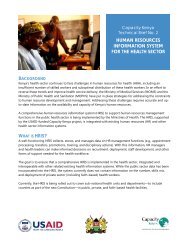
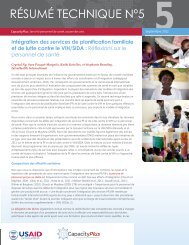
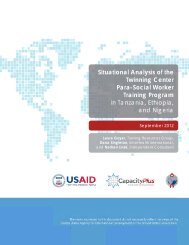
![view Unit 14: Emergency Contraceptive Pills [PDF 319KB]](https://img.yumpu.com/50082157/1/184x260/view-unit-14-emergency-contraceptive-pills-pdf-319kb.jpg?quality=85)

![view Unit 8: Intrauterine Contraceptive Devices [PDF 992KB]](https://img.yumpu.com/47853006/1/184x260/view-unit-8-intrauterine-contraceptive-devices-pdf-992kb.jpg?quality=85)

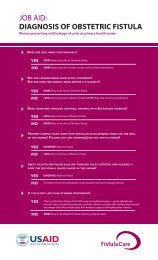

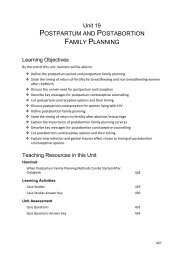
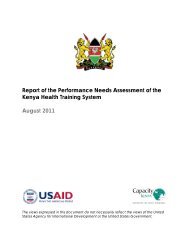
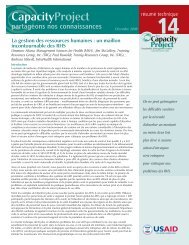

![view Unit 15: Lactational Amenorrhea Method [PDF 259KB]](https://img.yumpu.com/30000479/1/184x260/view-unit-15-lactational-amenorrhea-method-pdf-259kb.jpg?quality=85)